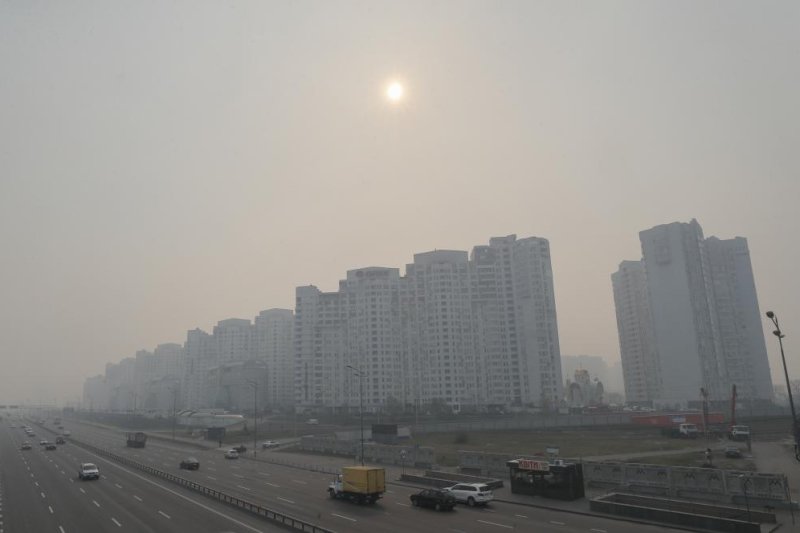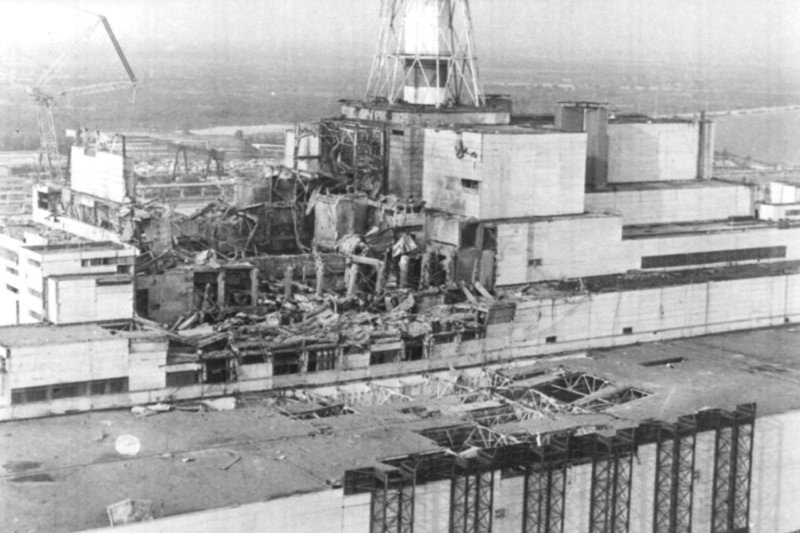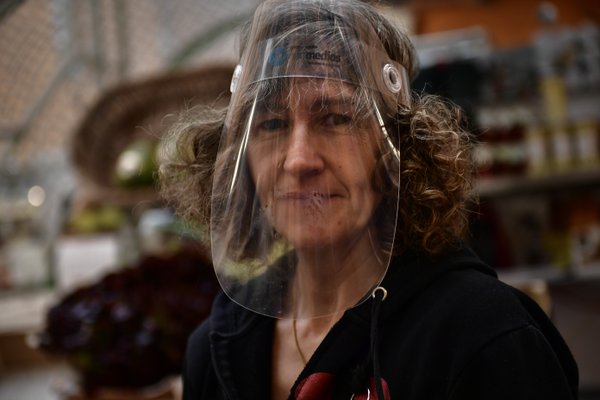By Christen McCurdy APRIL 18, 2020

Smog haze hangs over Kiev, Ukraine, on Friday. This week air quality in Ukraine ranked as worst in the world due to multiple fires burning in the country, including in the Chernobyl exclusion zone. Photo by Sergey Dolzhenko/EPA-EFE
April 18 (UPI) -- Multiple wildfires spreading across Ukraine have burned 38 homes and 15.4 square miles of forest and forced residents to keep their windows shut due to air pollution.
On Friday and Saturday the concentration of dust and burning residues have at least doubled and may have increased fourfold, with concentrations of nitrogen dioxide, sulfur dioxide and formaldehyde increasing by two or three times over typical amounts, the Kyiv Post reported.
Air quality levels in Ukraine this week have registered as the worst in the world.As of Saturday morning, Kiev's Air Quality Index ranged from 360 and 499 in different parts of the city, rated "hazardous," though markers had returned to a "moderate" rating by Saturday evening.
Meteorologists say air quality in Kiev, the country's capital and largest city, may improve early next week due to a predicted change in wind direction.
Kiev officials initially said smoke in the city was caused by fires in the Chernobyl exclusion zone, but Anatoly Prokopenko, deputy director of the Ukrainian Hydrometeorological Center, said fires in the Zhytomyr Oblast -- a large province in the north of Ukraine -- had caused Kiev to be blanketed in smoke since Thursday night.
By Saturday evening, six of 15 fires in the Zhytomyr Oblast forests had been extinguished and five more had been contained, said Volodymyr Demchuk, director of the emergency response at the State Emergency Service.
Firefighters were also trying to extinguish four fires in the Chernobyl exclusion zone. The Chernobyl fires broke out April 4 and were considered contained by Tuesday, but flared up again Thursday due to high winds in the area.
A report released Wednesday by the French Radioprotection and Nuclear Safety Institute found elevated levels of radiation in the area, but Demchuk was quoted in the Kyiv Post on Saturday saying radiation was at a normal level.
Ukrainian officials: Fires out near Chernobyl nuclear plant

In this photo taken from the roof of Ukraine's Chernobyl nuclear power plant late Friday April 10, 2020, a forest fire is seen burning near the plant inside the exclusion zone. Ukrainian firefighters are labouring to put out two forest blazes in the area around the Chernobyl nuclear power station that was evacuated because of radioactive contamination after the 1986 explosion at the plant. (Ukrainian Police Press Office via AP)
Posted: Tue Apr 14, 2020
KYIV, Ukraine (AP) — Ukrainian emergency officials said Tuesday they have extinguished forest fires in the radiation-contaminated area near the Chernobyl nuclear power plant, but acknowledged that grass was still smoldering in some areas.
Hundreds of firefighters backed by aircraft have been battling several forest fires around Chernobyl for the past 10 days. They contained the initial blazes, but new fires raged closer to the decommissioned plant.
Emergencies Service chief Mykola Chechetkin reported to President Volodymyr Zelenskiy that rains helped firefighters put out the flames, but acknowledged that it would take a few more days to extinguish smoldering grass.
Chechetkin said emergency workers have prevented the fire from engulfing radioactive waste depots and other facilities in Chernobyl.
The emergencies service said radiation levels in the capital, Kyiv, about 100 kilometers (60 miles) south of the plant, were within norms.
On Monday, activists warned that the blazes were getting dangerously close to waste storage facilities.
Yaroslav Yemelyanenko, a member of the public council under the state agency in charge of the closed zone around the plant, said one fire was raging within 2 kilometers (about 1.2 miles) from one of the radioactive waste depots.
Last week, officials said they tracked down a person suspected of triggering the blaze by setting dry grass on fire in the area. The 27-year-old man said he burned grass “for fun” and then failed to extinguish the fire when the wind caused it to spread quickly.
On Monday, police said that another local resident burned waste and accidentally set dry grass ablaze, triggering another devastating forest fire. They said he failed to report the fire to the authorities.
The 2,600-square-kilometer (1,000-square-mile) Chernobyl Exclusion Zone was established after the April 1986 disaster at the plant that sent a cloud of radioactive fallout over much of Europe. The zone is largely unpopulated, although about 200 people have remained despite orders to leave.
Blazes in the area have been a regular occurrence. They often start when residents set dry grass on fire in the early spring — a widespread practice in Ukraine, Russia and some other ex-Soviet nations that often leads to devastating forest fires.
Copyright 2020 Associated Press. All rights reserved.
A report released Wednesday by the French Radioprotection and Nuclear Safety Institute found elevated levels of radiation in the area, but Demchuk was quoted in the Kyiv Post on Saturday saying radiation was at a normal level.
Ukrainian officials: Fires out near Chernobyl nuclear plant

In this photo taken from the roof of Ukraine's Chernobyl nuclear power plant late Friday April 10, 2020, a forest fire is seen burning near the plant inside the exclusion zone. Ukrainian firefighters are labouring to put out two forest blazes in the area around the Chernobyl nuclear power station that was evacuated because of radioactive contamination after the 1986 explosion at the plant. (Ukrainian Police Press Office via AP)
Posted: Tue Apr 14, 2020
KYIV, Ukraine (AP) — Ukrainian emergency officials said Tuesday they have extinguished forest fires in the radiation-contaminated area near the Chernobyl nuclear power plant, but acknowledged that grass was still smoldering in some areas.
Hundreds of firefighters backed by aircraft have been battling several forest fires around Chernobyl for the past 10 days. They contained the initial blazes, but new fires raged closer to the decommissioned plant.
Emergencies Service chief Mykola Chechetkin reported to President Volodymyr Zelenskiy that rains helped firefighters put out the flames, but acknowledged that it would take a few more days to extinguish smoldering grass.
Chechetkin said emergency workers have prevented the fire from engulfing radioactive waste depots and other facilities in Chernobyl.
The emergencies service said radiation levels in the capital, Kyiv, about 100 kilometers (60 miles) south of the plant, were within norms.
On Monday, activists warned that the blazes were getting dangerously close to waste storage facilities.
Yaroslav Yemelyanenko, a member of the public council under the state agency in charge of the closed zone around the plant, said one fire was raging within 2 kilometers (about 1.2 miles) from one of the radioactive waste depots.
Last week, officials said they tracked down a person suspected of triggering the blaze by setting dry grass on fire in the area. The 27-year-old man said he burned grass “for fun” and then failed to extinguish the fire when the wind caused it to spread quickly.
On Monday, police said that another local resident burned waste and accidentally set dry grass ablaze, triggering another devastating forest fire. They said he failed to report the fire to the authorities.
The 2,600-square-kilometer (1,000-square-mile) Chernobyl Exclusion Zone was established after the April 1986 disaster at the plant that sent a cloud of radioactive fallout over much of Europe. The zone is largely unpopulated, although about 200 people have remained despite orders to leave.
Blazes in the area have been a regular occurrence. They often start when residents set dry grass on fire in the early spring — a widespread practice in Ukraine, Russia and some other ex-Soviet nations that often leads to devastating forest fires.
Copyright 2020 Associated Press. All rights reserved.
Ukraine gov't: Fire under control near Chernobyl nuclear power station

Firefighters battle a wildfire in the exclusion zone near the Chernobyl nuclear power station on Friday. Photo by EPA-EFE
April 14 (UPI) -- The Ukrainian government said Tuesday a large fire burning in the "exclusion zone" near the Chernobyl nuclear power station is under control, but some witnesses say that doesn't appear to be true.
The Ukrainian interior ministry said there "were no open fires" remaining within the 18-mile zone that surrounds the plant, which was the site of one of the world's worst nuclear accidents in 1986.
Interior ministry officials said crews had dumped 500 tons of water onto the fire and there's only "a slight smoldering of the forest floor with separate cells" remaining. They said 500 people and 110 vehicles were sent into the exclusion zone to fight the blaze.
Background radiation in Kiev and the surrounding region is within normal limits, the ministry added.
Ukraine's State Agency on Exclusion Zone Management said in a Facebook post that fires were still burning in the Rossokha village, a scrapyard containing the irradiated emergency vehicles that responded to the accident.
A Chernobyl tour operator, however, said the fire is still out of control and has reached the abandoned city of Pripyat, less than two miles from a site where contaminated debris from the accident is stored.
The situation has raised some concern that radiation still contained the exclusion zone could be spread by the fire, which started on April 4.
The No. 4 reactor at Chernobyl exploded and experienced a core meltdown following a safety test at the plant on April 26, 1986. It's one of only two nuclear disasters rated at seven, the maximum level, on the International Nuclear Event Scale. More than 77,000 square miles in Ukraine, Belarus and Russia, which in 1986 were all part of the Soviet Union, were seriously contaminated by radiation.
The disaster directly killed less than 50 people, mainly emergency first responders known as the Chernobyl "liquidators," but it's estimated that as many as 60,000 have died over the last three decades due to ailments related to the radiation fallout. Officials concluded design flaws at the plant contributed to the accident.
Scientists have said the area around the Chernobyl plant won't be habitable for 20,000 years.
Wildfire near Chernobyl releases spike in radiation
By Clyde Hughes

A wildfire near the Chernobyl Nuclear Power Plant in Ukraine, show following the April 26, 1986 explosion, burned 50 acres inside an established exclusion zone. UPI File Photo | License Photo
April 6 (UPI) -- A weekend wildfire in a forest inside the shuttered Chernobyl Nuclear Power Plant's exclusion zone in Ukraine caused radiation to spike in the area.
The fire, which started Saturday, burned about 250 acres.
The National Police said the fire started "on dry grass and bushes" near the village of Vladimirovka. Firefighters made 42 water drops on the largest fires as 124 others battled smaller blazes started by the wildfire.
Police said 50 of the acres burned were inside the exclusion zone. No new fires were reported in the area as of Monday morning.
Yegor Firsov, Ukraine's ecological inspection service chief, said the fire caused radiation to spike.
"There is bad news -- in the center of the fire, radiation is above normal," Firsov said, posting a video of a Geiger counter on Facebook. "As you can see in the video, the readings of the device are 2.3, when the norm is 0.14. But this is only within the area of the fire outbreak."
He would later say the fire did not "affect the radiation situation" in the Ukrainian capital of Kiev and suburbs, so people should not be afraid to open windows there.
The police said it opened a criminal investigation into the fire for possible violations of fire safety requirements.
Vladimirovka is part of a deserted 1,000-square-mile exclusion zone established after the 1986 Chernobyl Nuclear Power Plant explosion that sent radioactive fallout across Europe and exposed millions to heightened levels of radiation.

Firefighters battle a wildfire in the exclusion zone near the Chernobyl nuclear power station on Friday. Photo by EPA-EFE
April 14 (UPI) -- The Ukrainian government said Tuesday a large fire burning in the "exclusion zone" near the Chernobyl nuclear power station is under control, but some witnesses say that doesn't appear to be true.
The Ukrainian interior ministry said there "were no open fires" remaining within the 18-mile zone that surrounds the plant, which was the site of one of the world's worst nuclear accidents in 1986.
Interior ministry officials said crews had dumped 500 tons of water onto the fire and there's only "a slight smoldering of the forest floor with separate cells" remaining. They said 500 people and 110 vehicles were sent into the exclusion zone to fight the blaze.
Background radiation in Kiev and the surrounding region is within normal limits, the ministry added.
Ukraine's State Agency on Exclusion Zone Management said in a Facebook post that fires were still burning in the Rossokha village, a scrapyard containing the irradiated emergency vehicles that responded to the accident.
A Chernobyl tour operator, however, said the fire is still out of control and has reached the abandoned city of Pripyat, less than two miles from a site where contaminated debris from the accident is stored.
The situation has raised some concern that radiation still contained the exclusion zone could be spread by the fire, which started on April 4.
The No. 4 reactor at Chernobyl exploded and experienced a core meltdown following a safety test at the plant on April 26, 1986. It's one of only two nuclear disasters rated at seven, the maximum level, on the International Nuclear Event Scale. More than 77,000 square miles in Ukraine, Belarus and Russia, which in 1986 were all part of the Soviet Union, were seriously contaminated by radiation.
The disaster directly killed less than 50 people, mainly emergency first responders known as the Chernobyl "liquidators," but it's estimated that as many as 60,000 have died over the last three decades due to ailments related to the radiation fallout. Officials concluded design flaws at the plant contributed to the accident.
Scientists have said the area around the Chernobyl plant won't be habitable for 20,000 years.
Wildfire near Chernobyl releases spike in radiation
By Clyde Hughes

A wildfire near the Chernobyl Nuclear Power Plant in Ukraine, show following the April 26, 1986 explosion, burned 50 acres inside an established exclusion zone. UPI File Photo | License Photo
April 6 (UPI) -- A weekend wildfire in a forest inside the shuttered Chernobyl Nuclear Power Plant's exclusion zone in Ukraine caused radiation to spike in the area.
The fire, which started Saturday, burned about 250 acres.
The National Police said the fire started "on dry grass and bushes" near the village of Vladimirovka. Firefighters made 42 water drops on the largest fires as 124 others battled smaller blazes started by the wildfire.
Police said 50 of the acres burned were inside the exclusion zone. No new fires were reported in the area as of Monday morning.
Yegor Firsov, Ukraine's ecological inspection service chief, said the fire caused radiation to spike.
"There is bad news -- in the center of the fire, radiation is above normal," Firsov said, posting a video of a Geiger counter on Facebook. "As you can see in the video, the readings of the device are 2.3, when the norm is 0.14. But this is only within the area of the fire outbreak."
He would later say the fire did not "affect the radiation situation" in the Ukrainian capital of Kiev and suburbs, so people should not be afraid to open windows there.
The police said it opened a criminal investigation into the fire for possible violations of fire safety requirements.
Vladimirovka is part of a deserted 1,000-square-mile exclusion zone established after the 1986 Chernobyl Nuclear Power Plant explosion that sent radioactive fallout across Europe and exposed millions to heightened levels of radiation.


























